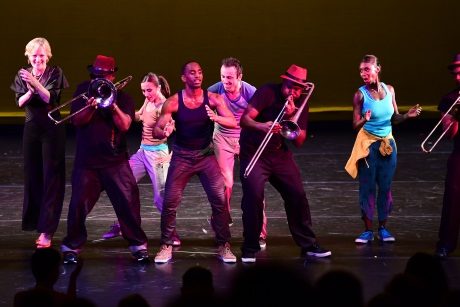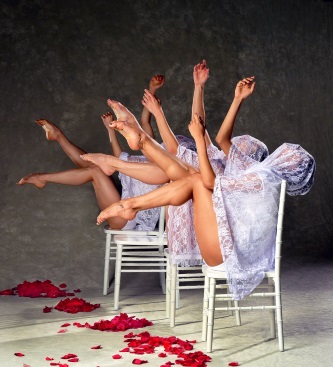Baseball players take the winter off. Football players do the same in the summer. Ballet dancers are of a different breed. When their companies go on hiatus, typically in early June, they find other gigs. Thus, Chamber Dance Project reinvented itself in the Washington, D.C., region five years ago. Founder Diane Coburn Bruning, a long-time freelance choreographer, relocated to the area from New York during the recession to work with some of our region’s theater and opera companies. So taken was she by the vibrant performing arts community that she resuscitated her former New York troupe for summer-only performances featuring ballet dancers from across the country in their off-season.

This year’s program at Sidney Harman Hall, Ballet, Brass & Song, like Chamber Dance Project’s prior evenings, features live musical accompaniment, by equally chamber-sized music groups. This year Mosche Brass Band kicked off the program on energetic notes and later, a string quartet helmed by Claudia Chudacoff provided lovely renditions of The Prayer of the Matador, Op 34 by Joaquin Turina and a Prokofiev sonata from Allegro Con Brio featuring Chudacoff and Sally McLain on violins, along with accompanying the choreography. Bruning’s six dancers hail from the Milwaukee, Cincinnati, Kansas City, and Washington ballet companies.
Choreographically Bruning favors a style of contemporary ballet that demands a high level of technical prowess from its performers, while also pushing them into weighted, gravity heavy modern dance, sassy jazz riffs, a Texas two-step and even some suggestions of soft shoe in the evening’s closing show-piece.
But bold brass opened the program at Sidney Harman Hall, the locally based Mosche Brass Band marching down the aisle, like a shiny Second Line orchestra. New York choreographer Jennifer Archibald draws from modern dance and vernacular styles including hip hop. She was an unexpected choice for a handful of pro ballet dancers, but in her Rue Noir, created last year, the dancers were mostly able to tackle the strutting, flirty and freewheeling attitudes with which Archibald seasoned her dance. The bright brass quartet, helped the dancers bounce, bound and strut. The smoothest of the bunch, Gian Carlo Perez, displayed his dashing confidence in a jaunty cock of his head, a quick shoulder lift and a sporty leg flick. Patric Palkens was the bow-tied nerd of the bunch, his subtle stiltedness giving him that slight outsider aura. Andile Ndlovu was the level headed cool dude, bopping and soaring airborne to the pumping brass. The two women – Luz San Miguel and Angelina Sansone – were not nearly as personable, though their technique, the way the wrapped and draped their bodies over their male partners, sliced the air with their legs and doled out perfect pirouettes on pointe was all wonderful. If only they could have had a bit more fun.

In Exit Wounds … and then they come home, a taut male duet featuring Ndlovu and Perez, the men battle demons, their own and each other. Clad in muted street clothes they push against one another, pull away, are lifted upside down, then slither over each other’s backs. A few spare gestural moments – Ndlovu covers Perez’s eyes like a blindfold, tremoring hand, a grabbed handshake – suggest this encounter could be between wounded warriors, a band of brothers struggling and bonding, particularly in the final moment, Perez rocks Ndlovu like a baby. The music, an oft-used for dance string quartet by Philip Glass was briskly played by Claudia Chudacoff and Sally McLain both on violin, Derek Smith (viola) and Sean Neidlinger (cello).
Sur, a modern tango, dissects the form, easing the three couples in and out of partnerships in Argentinean choreographer Jorge Amarante’s choreography, created for the company in 2014. Opening with Peteris Vasks more cerebral String Quartet No. 4, Movements I and II, initially the piece only hinted at tango with dips, gliding figure-eight footwork on the floor and ballroom-styled embraces. The men wore subdued slacks, t-shirts, and vests, while the women (San Miguel, Sansone and Francesca Dugarte) donned flirty skirts and camisoles. A central duet by Sansone and Palkens stripped the dancers down even further, seeking tango’s sensual roots as the music changed to pure tango: Astor Piazzolla’s Libertango, Four for Tango and Tango Ballet. The women exhibited a far more grounded stance than traditional tangueras, who balance on four-inch heels. Lowering their centers of gravity suggested a more equal partnership; in fact, at times the female partners took the lead as the men gamely followed.
A female trio, Arranged, by Bruning, features veiled women struggling with a presumed arranged marriage. Seated in white chairs, the tremor and sway, curling up, facing one another, though their eyes are never visible under the lace veils. Another overused dance score, Arvo Part’s Fratres vigorously played by the string quartet, adds building tension to the compact and visually arresting work, which also features piles of deep red rose petals at the dancers’ feet.

The program closed with a lighthearted walk through a selection from composer Cole Porter’s witty songbook. Bruning’s stylized choreography for Songs By Cole and tailored period costumes by Bekah Nettekoven–Tello add flair to the jazzy, bluesy stylings of singer Lena Seikaly, accompanied by Barry Gurley on piano and Paul Henry on bass. The piece’s centerpiece was all about the dress. For a sultry Night and Day, designer Nettekoven-Tello created an Erte-inspired gown in a black and white Harlequin pattern with oversized kimono sleeves and a train. Dugarte swirled, swooned and was lifted by Perez and Palkens to great billowy effect, like the sails of a ship. C’est Magnifique snapped with silhouetted dancers strutting, their chins jutting beneath Fosse-esque bowlers, as San Miguel and Perez did a jaunty high-low walk. The three men got mileage out of cowboy hats and boots with tinkling spurs in Porter’s Don’t Fence Me In. For Miss Otis Regrets, a bitterly ironic spoof by Porter, Bruning missed the boat, taking the pas de deux in too serious a direction. Yet, the whole piece cutely demonstrated her show-business streak in and her love for easy-to-digest song-and-dance numbers that tickle the palate like a kick from a glass of champagne.
Running time: Two hours and 15 minutes, including one intermission
Ballet, Brass & Song plays through June 24, 2017, at Shakespeare Theatre’s Sidney Harman Hall — 610 F Street, NW, in Washington, DC. For tickets call (202) 499-2297, or purchase them online.




